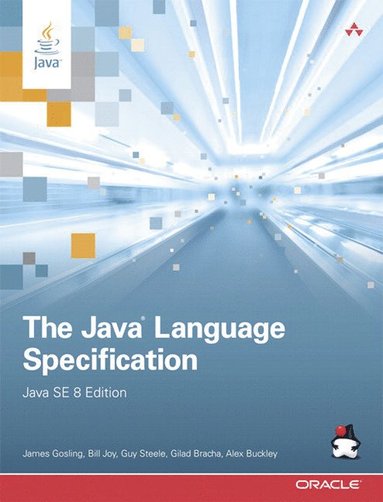
- Format
- Häftad (Paperback)
- Språk
- Engelska
- Antal sidor
- 792
- Utgivningsdatum
- 2014-05-06
- Upplaga
- 1
- Förlag
- Addison Wesley
- Medarbetare
- Joy, Bill / Steele, Guy L. / Bracha, Gilad / Buckley, Alex
- Illustrationer
- black & white illustrations, black & white tables
- Dimensioner
- 234 x 178 x 43 mm
- Vikt
- Antal komponenter
- 1
- ISBN
- 9780133900699
- 1199 g
The Java Language Specification, Java SE 8 Edition
Slutsåld
Kundrecensioner
Fler böcker av James Gosling
-
NeWS Book
James Gosling, David S H Rosenthal, Michelle J Arden, David S H Rosenthal, M J Arden
This book is an introduction to NeWS: the Networked, Extensible, Window System from Sun Microsystems. It is oriented towards people who have a basic knowledge of programming and window systems who would like to understand more about window systems...
-
Economics, Politics, and American Public Policy
James Gosling, Marc Allen Eisner, James Gosling, Marc Allen Eisner
This text introduces students to the interrelationship of politics and economics in American public policymaking: how economic concerns have been legislated into law since Franklin Roosevelt's time and how politics (e.g., Washington gridlock) affe...
Övrig information
James Gosling is the creator of the Java programming language and a former Fellow at Sun Microsystems. He developed the original Java compiler and Java Virtual Machine, and was a principal in the Andrew project at Carnegie Mellon University, where he earned a Ph.D. in Computer Science. He joined Liquid Robotics as Chief Software Architect in 2011. Bill Joy is a co-founder of Sun Microsystems and was the principal architect of the Berkeley version of UNIX(r), for which he received a lifetime achievement award from the USENIX Association in 1993. Joy has had a central role in shaping the Java programming language. He joined KPCB as a Greentech Partner in 2005. Guy L. Steele Jr. is a Software Architect at Oracle Labs, where he conducts research in language design and implementation strategies, parallel algorithms, and computer arithmetic. Steele is a co-creator of the Scheme programming language, an ACM Fellow, an IEEE Fellow, and a member of the National Academy of Engineering. Gilad Bracha is the creator of the Newspeak programming language and a former Distinguished Engineer at Sun Microsystems. Prior to Sun, he worked on Strongtalk, the Animorphic Smalltalk System. He holds a Ph.D. in Computer Science from the University of Utah. Alex Buckley is the Specification Lead for the Java programming language and the Java Virtual Machine at Oracle. He holds a Ph.D. in Computing from Imperial College London.
Innehållsförteckning
Preface to the Java SE 8 Edition xxi
Chapter 1: Introduction 1
1.1 Organization of the Specification 2
1.2 Example Programs 6
1.3 Notation 6
1.4 Relationship to Predefined Classes and Interfaces 7
1.5 Feedback 7
1.6 References 7
Chapter 2: Grammars 9
2.1 Context-Free Grammars 9
2.2 The Lexical Grammar 9
2.3 The Syntactic Grammar 10
2.4 Grammar Notation 10
Chapter 3: Lexical Structure 15
3.1 Unicode 15
3.2 Lexical Translations 16
3.3 Unicode Escapes 17
3.4 Line Terminators 19
3.5 Input Elements and Tokens 19
3.6 White Space 20
3.7 Comments 21
3.8 Identifiers 22
3.9 Keywords 24
3.10 Literals 24
3.11 Separators 38
3.12 Operators 38
Chapter 4: Types, Values, and Variables 41
4.1 The Kinds of Types and Values 41
4.2 Primitive Types and Values 42
4.3 Reference Types and Values 52
4.4 Type Variables 57
4.5 Parameterized Types 59
4.6 Type Erasure 64
4.7 Reifiable Types 64
4.8 Raw Types 66
4.9 Intersection Types 70
4.10 Subtyping 71
4.11 Where Types Are Used 75
4.12 Variables 80
Chapter 5: Conversions and Contexts 91
5.1 Kinds of Conversion 94
5.2 Assignment Contexts 107
5.3 Invocation Contexts 112
5.4 String Contexts 114
5.5 Casting Contexts 114
5.6 Numeric Contexts 124
Chapter 6: Names 129
6.1 Declarations 130
6.2 Names and Identifiers 137
6.3 Scope of a Declaration 139
6.4 Shadowing and Obscuring 142
6.5 Determining the Meaning of a Name 148
6.6 Access Control 161
6.7 Fully Qualified Names and Canonical Names 169
Chapter 7: Packages 173
7.1 Package Members 173
7.3 Compilation Units 177
7.4 Package Declarations &...
Du kanske gillar
-
Deep Utopia
Nick Bostrom
Häftad -
Lean Startup
Eric Ries
Häftad -
HTML and CSS
Jon Duckett
Häftad -
Doppelganger
Naomi Klein
Häftad
